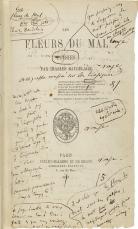French Decadence
Created by Shalyn Delhaes on Mon, 11/29/2021 - 12:46
Decadence is a literary movement especially of the late 19th-century France and England characterized by refined aestheticism, artifice, and the quest for new sensations. It first emerged in France in the mid-19th century before spreading to the rest of Europe. For France and England, the end of the 18th century and the 19th century were tough times. During the late 18th century, France was going through the French Revolution and the government was failing to meet the needs of its people. As a way to cope with the oncoming changes, people turned to decadence. This led to an indulgent lifestyle during these times that focused on consumption of material goods and feel-good experiences. The turn to decadence in France and England originated from a place of fear. France was trying to pretend that everything was fine financially and politically when it wasn’t.
Timeline
Chronological table
| Date | Event | Created by | Associated Places | |
|---|---|---|---|---|
| 1857 |
"Les Fleurs du mal"The term ‘decadent’ was first coined to describe the new movement by a celebrated French poet Charles Baudelaire in his 1857 volume of poetry, Les Fleurs du Mal (‘The Flowers of Evil’). Les Fleurs du mal, (French: “The Flowers of Evil”) collection of poems published in 1857 by Charles Baudelaire. A second edition, published in 1861, was greatly enlarged and enhanced but omitted six poems that had been banned. (These were first republished in 1866 in Belgium in the collection Les Épaves, but they remained banned in France until 1949.) The otherwise definitive edition of Les Fleurs du mal was published posthumously in 1868. Contemporary scholars consider the work to be the fullest expression of French Romantic poetry. Les Fleurs du mal is composed of six sections, each with a theme—a structure that was new to French poetry. The sections are “Spleen et idéal,” “Tableaux parisiens,” “Le Vin,” “Fleurs du mal,” “Révolte,” and “La Mort.” Shifting in style from the rhetorical to the impressionistic, from the abstract to the intensely physical, Baudelaire balances banality and originality, the prosaic and the melodic, to emphasize the eternal interdependence of opposites. The attached picture is the first edition of Les Fleurs du mal with author's notes. Citation: https://www.britannica.com/topic/Les-Fleurs-du-mal
|
Shalyn Delhaes | ||
| 1884 |
"À Rebours"In 1884, French novelist Maurice Barrès defined decadent writers and artists as those who had fallen under the influence of Baudelaire’s poetry, ‘Gothic’ fiction, and the macabre writings of Edgar Allen Poe. In the same year, Joris-Karl Huysmans published his ground-breaking novel, À Rebours (‘Against Nature’), which is widely considered the quintessential example of decadent literature. The novel tells the story of an eccentric, a reclusive aristocrat who retreats into his own world of aesthetic and erotic pleasures. Wilde’s self-developing individual, like the Decadent, subverts Victorian concepts of “natural” manliness and morality. It eschews such Victorian values as conformity, consistency, and sincerity. The self-absorption and mental stimulation practiced by such Decadents as Des Esseintes in Joris-Karl Huysmans’ À rebours exemplify the positive values of self-realization and autonomy for Wilde. For example, Des Esseintes secludes himself with his own fancies, nightmares, and visions—stimulated by art and literature. Citation: Article: “The Perversion of Decadence: The Cases of Oscar Wilde’s Dorian Gray and Salome.”
|
Shalyn Delhaes | ||
| 1893 |
Critics: Dorian Gray & DecadenceWhen discussing Wilde’s Decadence, critics usually focus on Dorian Gray. In his chapter “The Damnation of Decadence,” from London in the 1890s, Karl Beckson, for instance, he writes about Dorian Gray, this “most famous Decadent novel of the British 1890s […] sums up—and radicalizes—much that Wilde had read in Pater and in French literature” (47). In particular, critics assign Dorian’s hedonism, immorality, and androgyny to decadence; likewise, they point to his portrait’s corruption and decay as illustrating this decadence. For example, Barbara Belford writes: “One is never sure of the extent of Dorian’s sins, but it is his disregard for humanity and lack of generosity rather than any sexual act that determine his destruction […] when Lord Henry wants to seduce Dorian into the hedonistic life, he supplies him with a “poisonous” book, assumed to be À rebours, Wilde’s bible of the Decadence.” (173) London in the 1890s: A Cultural History was published by W W Norton & Co Inc; 1st edition (February 1, 1993) Citation: Article: “The Perversion of Decadence: The Cases of Oscar Wilde’s Dorian Gray and Salome.” |
Shalyn Delhaes |


